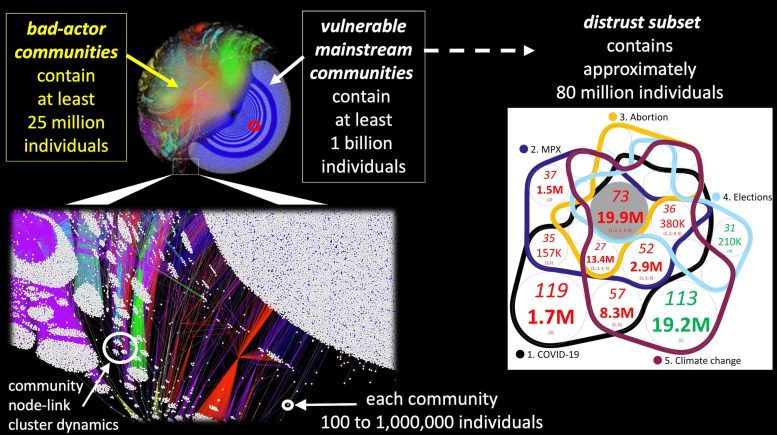A study forecasts that by mid-2024, bad actors are expected to increasingly utilize AI in their daily activities. The research, conducted by Neil F. Johnson and his team, involves an exploration of online communities associated with hatred. Their methodology includes searching for terminology listed in the Anti-Defamation League Hate Symbols Database, as well as identifying groups flagged by the Southern Poverty Law Center.
From an initial list of "bad-actor" communities found using these terms, the authors assess communities linked to by the bad-actor communities. The authors repeat this procedure to generate a network map of bad-actor communities—and the more mainstream online groups they link to.
Mainstream Communities Categorized as "Distrust Subset"
Some mainstream communities are categorized as belonging to a "distrust subset" if they host significant discussion of COVID-19, MPX, abortion, elections, or climate change. Using the resulting map of the current online bad-actor "battlefield," which includes more than 1 billion individuals, the authors project how AI may be used by these bad actors.
The bad-actor–vulnerable-mainstream ecosystem (left panel). It comprises interlinked bad-actor communities (colored nodes) and vulnerable mainstream communities (white nodes, which are communities to which bad-actor communities have formed a direct link). This empirical network is shown using the ForceAtlas2 layout algorithm, which is spontaneous, hence sets of communities (nodes) appear closer together when they share more links. Different colors correspond to different platforms. Small red ring shows 2023 Texas shooter's YouTube community as illustration. Right panel shows Venn diagram of the topics discussed within the distrust subset. Each circle denotes a category of communities that discuss a specific set of topics, listed at bottom. The medium size number is the number of communities discussing that specific set of topics, and the largest number is the corresponding number of individuals, e.g. gray circle shows that 19.9M individuals (73 communities) discuss all 5 topics. Number is red if a majority are anti-vaccination; green if majority is neutral on vaccines. Only regions with > 3% of total communities are labeled. Anti-vaccination dominates. Overall, this figure shows how bad-actor-AI could quickly achieve global reach and could also grow rapidly by drawing in communities with existing distrust. Credit: Johnson et al.
The authors predict that bad actors will increasingly use AI to continuously push toxic content onto mainstream communities using early iterations of AI tools, as these programs have fewer filters designed to prevent their usage by bad actors and are freely available programs small enough to fit on a laptop.
AI-Powered Attacks Almost Daily by Mid-2024
The authors predict that such bad-actor-AI attacks will occur almost daily by mid-2024—in time to affect U.S. and other global elections. The authors emphasize that as AI is still new, their predictions are necessarily speculative, but hope that their work will nevertheless serve as a starting point for policy discussions about managing the threats of bad-actor-AI.
Reference: "Controlling bad-actor-artificial intelligence activity at scale across online battlefields" by Neil F Johnson, Richard Sear and Lucia Illari, 23 January 2024, PNAS Nexus.
DOI: 10.1093/pnasnexus/pgae004
News
New mRNA therapy targets drug-resistant pneumonia
Bacteria that multiply on surfaces are a major headache in health care when they gain a foothold on, for example, implants or in catheters. Researchers at Chalmers University of Technology in Sweden have found [...]
Current Heart Health Guidelines Are Failing To Catch a Deadly Genetic Killer
New research reveals that standard screening misses most people with a common inherited cholesterol disorder. A Mayo Clinic study reports that current genetic screening guidelines overlook most people who have familial hypercholesterolemia, an inherited disorder that [...]
Scientists Identify the Evolutionary “Purpose” of Consciousness
Summary: Researchers at Ruhr University Bochum explore why consciousness evolved and why different species developed it in distinct ways. By comparing humans with birds, they show that complex awareness may arise through different neural architectures yet [...]
Novel mRNA therapy curbs antibiotic-resistant infections in preclinical lung models
Researchers at the Icahn School of Medicine at Mount Sinai and collaborators have reported early success with a novel mRNA-based therapy designed to combat antibiotic-resistant bacteria. The findings, published in Nature Biotechnology, show that in [...]
New skin-permeable polymer delivers insulin without needles
A breakthrough zwitterionic polymer slips through the skin’s toughest barriers, carrying insulin deep into tissue and normalizing blood sugar, offering patients a painless alternative to daily injections. A recent study published in the journal Nature examines [...]
Multifunctional Nanogels: A Breakthrough in Antibacterial Strategies
Antibiotic resistance is a growing concern - from human health to crop survival. A new study successfully uses nanogels to target and almost entirely inhibit the bacteria P. Aeruginosa. Recently published in Angewandte Chemie, the study [...]
Nanoflowers rejuvenate old and damaged human cells by replacing their mitochondria
Biomedical researchers at Texas A&M University may have discovered a way to stop or even reverse the decline of cellular energy production—a finding that could have revolutionary effects across medicine. Dr. Akhilesh K. Gaharwar [...]
The Stunning New Push to Protect the Invisible 99% of Life
Scientists worldwide have joined forces to build the first-ever roadmap for conserving Earth’s vast invisible majority—microbes. Their new IUCN Specialist Group reframes conservation by elevating microbial life to the same urgency as plants and [...]
Scientists Find a Way to Help the Brain Clear Alzheimer’s Plaques Naturally
Scientists have discovered that the brain may have a built-in way to fight Alzheimer’s. By activating a protein called Sox9, researchers were able to switch on star-shaped brain cells known as astrocytes and turn them into [...]
Vision can be rebooted in adults with amblyopia, study suggests
Temporarily anesthetizing the retina briefly reverts the activity of the visual system to that observed in early development and enables growth of responses to the amblyopic eye, new research shows. In the common vision [...]
Ultrasound-activated Nanoparticles Kill Liver Cancer and Activate Immune System
A new ultrasound-guided nanotherapy wipes out liver tumors while training the immune system to keep them from coming back. The study, published in Nano Today, introduces a biodegradable nanoparticle system that combines sonodynamic therapy and cell [...]
Magnetic nanoparticles that successfully navigate complex blood vessels may be ready for clinical trials
Every year, 12 million people worldwide suffer a stroke; many die or are permanently impaired. Currently, drugs are administered to dissolve the thrombus that blocks the blood vessel. These drugs spread throughout the entire [...]
Reviving Exhausted T Cells Sparks Powerful Cancer Tumor Elimination
Scientists have discovered how tumors secretly drain the energy from T cells—the immune system’s main cancer fighters—and how blocking that process can bring them back to life. The team found that cancer cells use [...]
Very low LDL-cholesterol correlates to fewer heart problems after stroke
Brigham and Women's Hospital's TIMI Study Group reports that in patients with prior ischemic stroke, very low achieved LDL-cholesterol correlated with fewer major adverse cardiovascular events and fewer recurrent strokes, without an apparent increase [...]
“Great Unified Microscope” Reveals Hidden Micro and Nano Worlds Inside Living Cells
University of Tokyo researchers have created a powerful new microscope that captures both forward- and back-scattered light at once, letting scientists see everything from large cell structures to tiny nanoscale particles in a single shot. Researchers [...]
Breakthrough Alzheimer’s Drug Has a Hidden Problem
Researchers in Japan found that although the Alzheimer’s drug lecanemab successfully removes amyloid plaques from the brain, it does not restore the brain’s waste-clearing system within the first few months of treatment. The study suggests that [...]






















